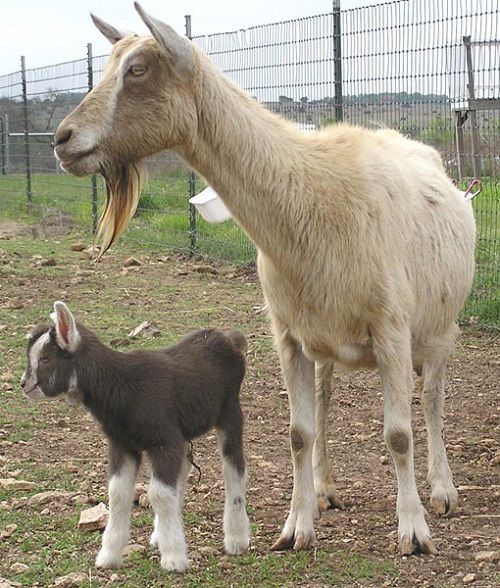Facts of the Toggenburg
"Scientific name for Toggenburg Goat is Capra aegagrus hircus". Capra aegagrus was derived from the Wild Goat (C. aegagrus). Toggenburg Goats are one among the varieties of goat that hail from the Toggenburg valley in Switzerland. The Toggenburg Goat attains its name from the name of the place of its origin. This goat breed is the oldest recognized dairy variety of goats. The Toggenburgs Goats breed is perhaps the hardiest of all goat varieties that is crossed with meat goats, such as the Boer and Kalahari red goats. The Toggenburg Goat breeds are extremely adapted to cooler conditions.
Features Toggenburg Goat
Toggenburg Goat breeds appears with a medium-sized body, with a dished or straight face and it is moderate in milk production. The matured male Toggenburg Goats attain a height that ranges from 34 to 38 inches, with a weight ranging from 150 to 200 pounds. The female breeds appear with a height between 30 to 32 inches, and they weigh 125 pounds maximum.
The Togenburg Goats appear with two white lines down their face from over each eye to the muzzle. The Toggenburg Goat breeds have a general Swiss Marked outline with different dilutions. The color of the Toggenburg Goats body is solid ranging from light brown to dark brown, without inclination for any shade. The Toggenburg Goat appear with different white-colored markings. The Toggenburg Goat have white-colored ears, with a dark mark in the middle.
The back legs of the Toggenburg Goat are white in color extending from hocks to hooves and their front legs are also white extending from knees descending with a dark stripe under the knee. The tail of the Toggenburg Goat breed is short, with a white-colored triangle on its both sides. Wattles, little undeveloped nubs of the skin of the Toggenburg Goat breed are situated on each side of their neck.
The Togenburg Goats are usually a gracious, calm and tender breed, and are also ideal pets, even though they are classified as dairy goats. The Toggenburg Goat are habitually extremely inquisitive and curious animals.
The average lifespan of the Togenburg Goats breed ranges from 8 years to 12 years. Mother Toggenburg Goat will call their young so they stay close at all times, a baby goat is called a "kid". The Mother and kid goat recognize each others calls as soon as the mother gives birth. Baby Toggenburg Goats are weaned off their moms after around 6 months. Its called "bleating" how goats communicate with each other. A "doe" or "nanny" is what a female Toggenburg Goat is called. A "buck or "billy" is what they call a male Toggenburg Goat. A male castrated goat is called a "wether". "Kidding" is the act of a goat giving birth.
Goats can even climb trees because they have great balance and some goat species can jump over 5 feet high. In latin "Capra" is the root of the word "capricious" which means whimsical, mischievous, quirky, bizarre and suitable to change fast. A Toggenburg Goats eyes are rectangular rather than round. At night they have excellent vision and can due just as much at night. A goat herder notice how much energy his goats had, after eating as we know now as the coffee bush and that's how coffee was first discovered.
Toggenburg Goats have no teeth in their upper front jaw. Toggenburg Goats have 24 molars and 8 incisors. Both sexes, female and male goats can have beards. Male Toggenburg Goats reach puberty at the age between 4 to 8 months and the female is between 7 to 10 months. Male Toggenburg Goats at the beginning of mating season go through a period called a "rut". The "rut" is the beginning of the courting for a doe, a very strong foul musky odor and fighting between bucks begins. Toggenburg Goats have a four chamber stomach, goats are "Ruminant" is any hoofed even-toed mammal, that digests its food in two stages. First by eating the raw materials and regurgitating a semi-digested form known as "cud" (ruminating: chewing the cud.) then eating the cud. "Wattles" is that little tufts of hair that dangles from the goats throat. Goats milk is higher in niacin, calcium and vitamin A than cows milk. A Toggenburg Goat is a herbivores, that eats leaves, grass, hay and furns {plant eaters}. There are over 210 breeds of goats in the world. Goats can be born without or with horns "polled".
Tetanus is something to watch out for in Toggenburg Goats and what are the proper shots to give them, (Tetanus-is an illness that is caused by Clostridium Tetany). Also do the research on de-worming your young Toggenburg Goats (kids) and do the research on the proper doses. Also look up "Cocci" (If your fecal test shows an high rate of cocci (over 200 per gram) you need to take action quickly with your young (kid). These are important facts so do your research on this if you are raising Toggenburg Goats, especially young Toggenburg Goats (kids). The goat is one of the 12 animals in the Chinese zodiac.
 Toggenburg Goats Thank for stopping in and checking out our website
Toggenburg Goats Thank for stopping in and checking out our website